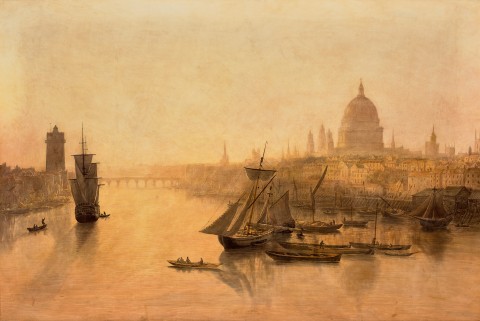EVENING ON THE THAMES, 1808
JOHN GLOVER
watercolour on paper
73.0 x 110.0 cm
signed and dated lower left: J. Glover 1808
Private collection
Leonard Joel, Melbourne, 20 April 1999, lot 141 (as ‘On the Thames’)
Private collection, Melbourne
John Glover and the Colonial Picturesque, Tasmanian Museum and Art Gallery, Hobart, 28 November 2003 – 1 February 2004; Art Gallery of South Australia, Adelaide, 10 February – 12 April 2004; National Gallery of Australia, Canberra, 24 April – 18 July 2004; National Gallery of Victoria, 13 August – 3 October 2004, cat. 28 (as ‘The Thames near St. Pauls’ Cathedral’)
Hansen, D., John Glover and the Colonial Picturesque, Tasmanian Museum and Art Gallery, Hobart, 2003, cat. 28, pp. 156, 157 (illus., as ‘The Thames near St. Pauls’ Cathedral’)
John Glover is widely recognised and much admired as one of the most significant landscape artists painting in the Australian colonies in the nineteenth century. His immigration to Van Diemen’s Land at the age of sixty-three is often recounted, yet comparatively little attention is paid to his long and successful career in England as an artist, exhibitor, teacher and contemporary of John Constable and J.M.W. Turner. In both England and Australia, Glover focused principally on picturesque landscapes and verdant rural surroundings, but he painted the occasional cityscape, as with this large and luminous watercolour of the Thames in 1808.
Glover associated with artistic and literary circles and is known to be a close reader of poetry; early sketchbook pages include many quotes and verses. William Wordsworth was one poet whom he read, and this tranquil scene corresponds closely with his sonnet Composed upon Westminster Bridge, 3 September 1802, which was first published in 1807.
Earth has not any thing to show more fair:
Dull would he be of soul who could pass by
A sight so touching in its majesty:
This City now doth, like a garment, wear
The beauty of the morning; silent, bare,
Ships, towers, domes, theatres, and temples lie
Open unto the fields, and to the sky;
All bright and glittering in the smokeless air.
Never did sun more beautifully steep
In his first splendour, valley, rock, or hill;
Ne’er saw I, never felt, a calm so deep!
The river glideth at his own sweet will:
Dear God! the very houses seem asleep;
And all that mighty heart is lying still!
While Wordsworth is describing the calm of early morning, Glover has positioned himself on London Bridge, looking towards Blackfriars Bridge, and is thus facing west, into a setting, rather than rising sun. The crowded port of London lies downstream, east of this view. Here we see only a small number of water craft, mostly moored at the wharves, the river workers ending their day’s toil. This view harks to a pictorial device used extensively by the French artist Claude Lorrain (1600 – 1682), looking across a seaport towards a low sun, and to the reflections and shadows cast upon the waters.1 Claude had many British imitators; Glover was not the only one to be known, but may be the best remembered, widely dubbed as the ‘the English Claude’.
In this expansive scene Glover’s view is not framed, as so often, by trees or geological features but rather is punctuated by the imposing and distinctive dome of St Pauls Cathedral on the right, and Watt’s shot tower, for bullet manufacturing, on the left, built less than twenty years earlier and the cutting edge of military technology.2 Here then, we see both the power of religion and of industrial and military might, at the heart of a metropolis immersed in the long Napoleonic war, yet simultaneously expanding its imperial control around the globe. Both London and Blackfriars bridges have since been rebuilt; railway, road and walking bridges now interrupt this view, including the Millennium Bridge which leads to Bankside, the (reconstructed) Globe Theatre and Tate Modern.3
1. See for example, Glover’s Conway Castle, 1796, in Hansen, D., John Glover and the Colonial Picturesque, Tasmanian Museum and Art Gallery, Hobart, 2004, cat. no. 8, p. 140.
2. Glover appears to position the shot tower before Blackfriars Bridge; other prints firmly locate it west of the bridge. For example, see https://www.britishmuseum.org/collection/object/P_1880-1113-5853
3. The National Gallery of Victoria holds Glover’s Sketchbook 72, which includes c. 1808 – 09 sketches of the Thames (NGV 1932-4)
ALISA BUNBURY
